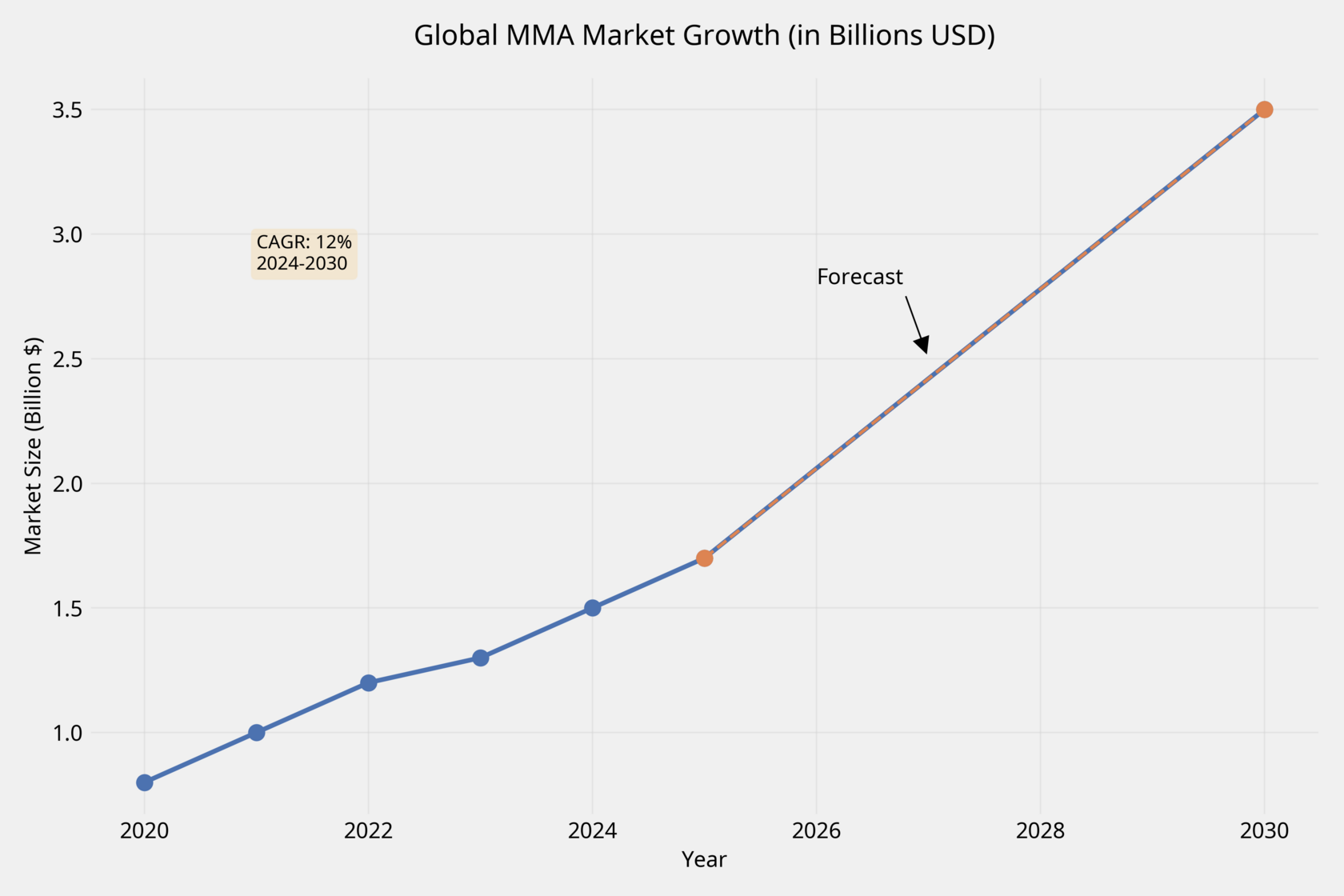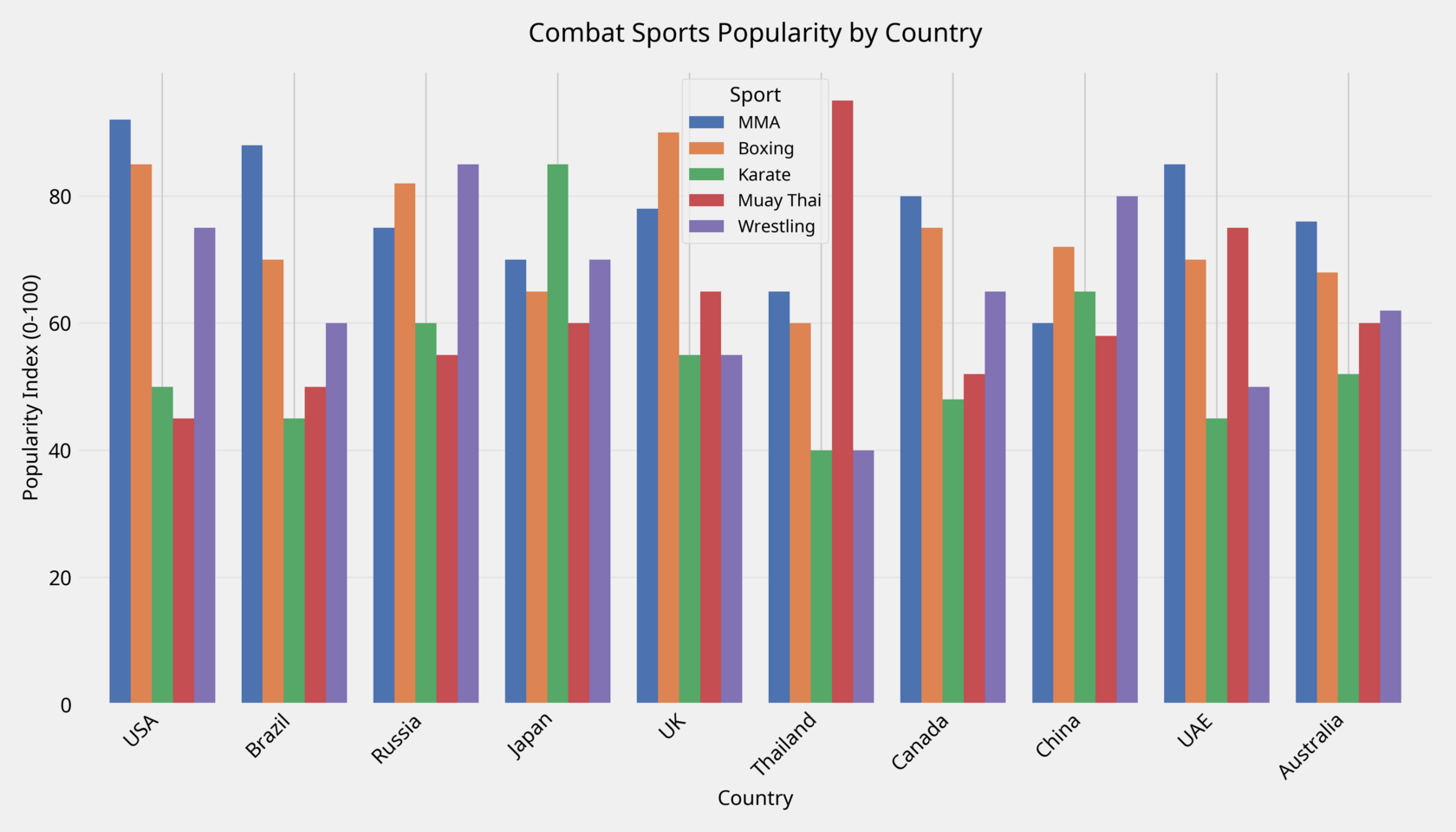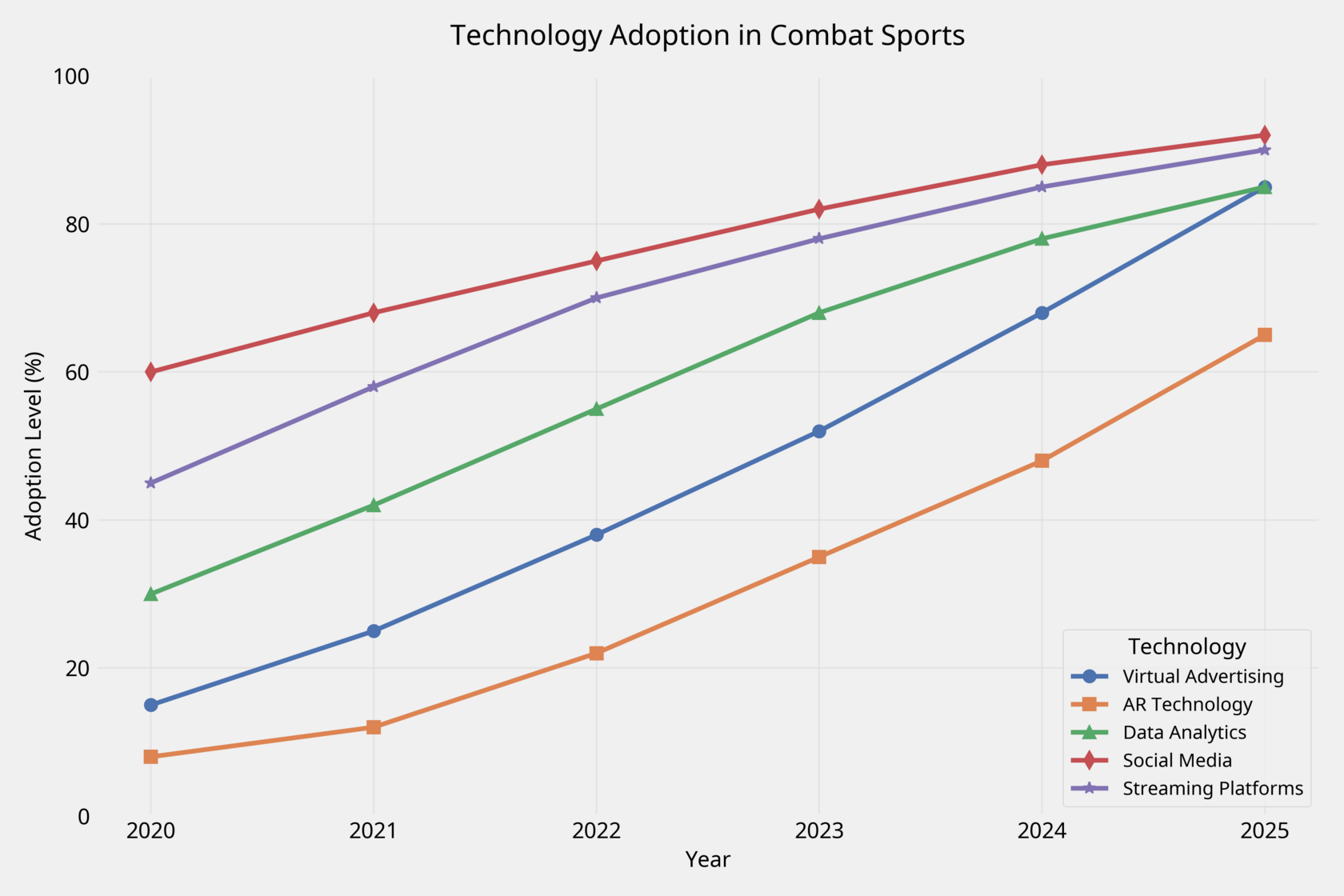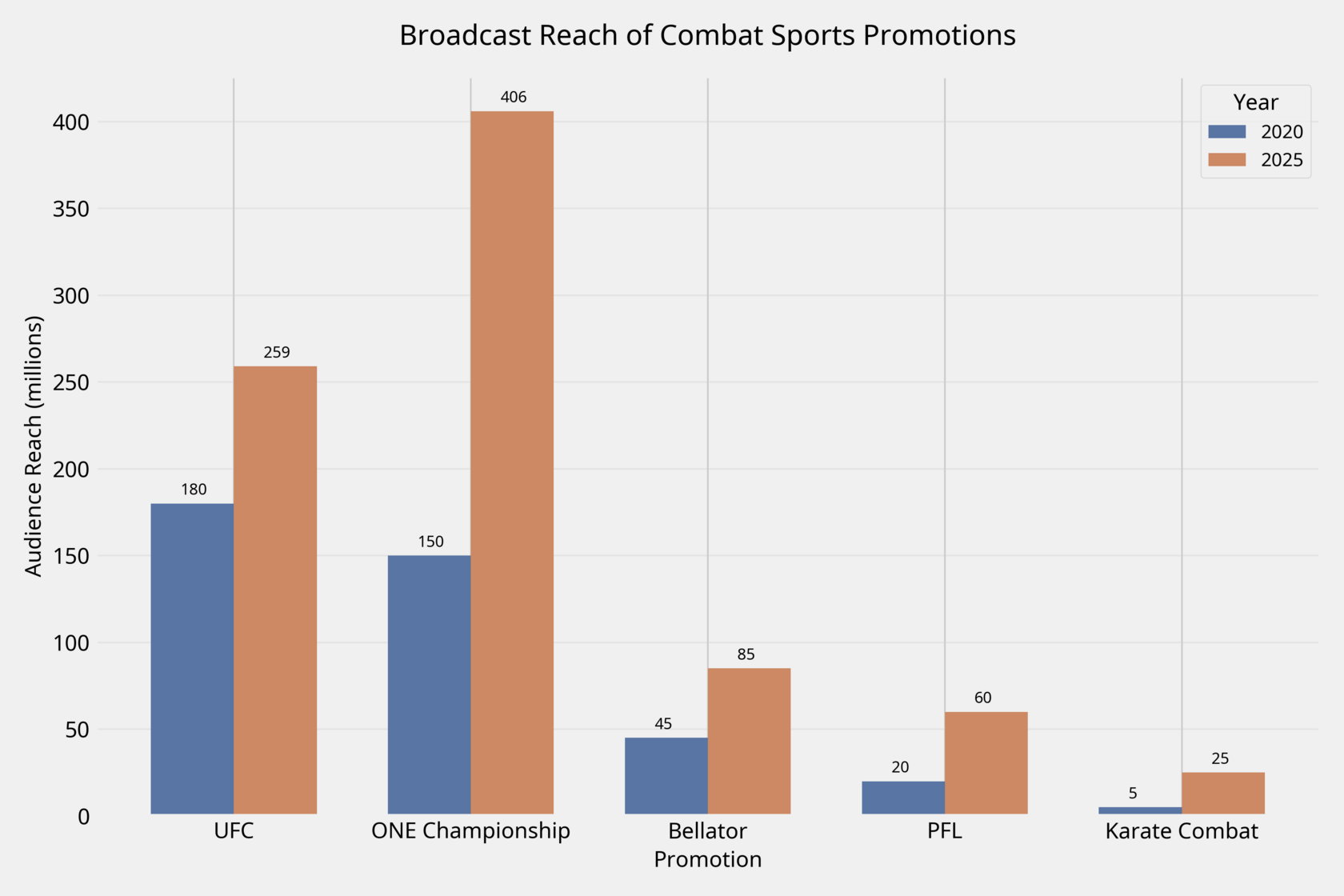Introduction
Combat sports are experiencing unprecedented growth in popularity worldwide. Over the past five years, we have observed a significant increase in the number of fans, expansion of competition geography, and implementation of advanced technologies that are transforming both the viewer experience and business models in this industry.
In this research, we will analyze key factors driving the popularity of various combat disciplines, compare their distribution across countries, examine technological innovations including virtual advertising and AR technologies, and evaluate the dynamics of increasing broadcasts, sponsors, and regions of distribution.
Global Statistics and Popularity Growth
Market Growth Dynamics
The global combat sports market is showing steady growth. According to research, the MMA market was valued at $1.5 billion in 2024 and is projected to grow at a compound annual growth rate (CAGR) of 12%, reaching $3.5 billion by 2030.

Several factors drive this growth:
1. Expanded Media Presence: Major promotions, including UFC, ONE Championship, and PFL, have secured large-scale deals with television and streaming platforms, significantly increasing their audience.
2. Globalization: Hosting events in new regions and countries, attracting fighters from around the world.
3 . Digitalization: Active use of social media and digital platforms to promote fighters and events.
4. Star Personalities: The emergence of charismatic fighters with large fan bases, such as Conor McGregor, Khabib Nurmagomedov, and Israel Adesanya.
Popularity by Countries and Regions
Research shows significant differences in the popularity of different combat disciplines depending on the region.

The USA remains the largest market for MMA, where UFC dominates with an estimated fan base exceeding 300 million people. Boxing also maintains strong positions, especially in the pay-per-view (PPV) segment.
Brazil is one of the key markets for MMA with a rich history of Brazilian Jiu-Jitsu and legendary fighters such as Anderson Silva and Jose Aldo.
Russia demonstrates a high level of interest in MMA and wrestling, supported by the success of Russian athletes in the international arena.
Japan maintains strong traditions in karate and other traditional martial arts but also shows growing interest in MMA.
United Kingdom has historically been a boxing center, but in recent years there has been a significant increase in MMA popularity.
Thailand remains the global center for Muay Thai, attracting both local and international athletes and spectators.
UAE is becoming a new hub for major combat sports events, especially after establishing a partnership with UFC.
Comparative Analysis of Various Combat Disciplines
MMA (Mixed Martial Arts)
MMA demonstrates the most impressive growth among all combat disciplines. UFC, as the leading promotion, has conducted more than 700 events worldwide by the first quarter of 2024. The average audience for a UFC event is approximately 509,000 viewers.
Key success factors for MMA:
•Complexity (combination of various fighting techniques)
•Spectacle and unpredictability of fights
•Effective marketing strategy and star creation
•Innovative approach to media content and fan interaction
Boxing
Despite competition from MMA, professional boxing maintains strong positions, especially in the heavyweight category and in countries with rich boxing traditions such as the United Kingdom, Mexico, and the USA.
Key features of modern boxing:
•Fragmentation (multiple championship belts and organizations)
•High purses for top fighters
•Strong historical traditions
•Growing competition with MMA for audience and sponsors
Karate and Traditional Martial Arts
Traditional martial arts such as karate, taekwondo, and kung fu maintain stable popularity, especially in Asia. The inclusion of karate in the Tokyo 2020 Olympic Games program (held in 2021) gave additional impetus to the development of this discipline.
Innovative formats such as Karate Combat, which combines traditional karate with a modern sports format and technological innovations, are attracting new audiences.
Muay Thai and Kickboxing
Muay Thai and kickboxing show steady growth, especially in Thailand, the Netherlands, and Eastern European countries. ONE Championship actively promotes Muay Thai alongside MMA, contributing to the globalization of this discipline.
Technological Development in the Combat Sports Industry
Implementation of Advanced Technologies
Over the past five years, the combat sports industry has actively implemented innovative technologies that transform both the viewer experience and the business models of promotions.

Virtual Advertising and AR Technologies
One of the most significant technological breakthroughs has been the implementation of virtual advertising and AR technologies in combat sports broadcasts.
Major promotions are increasingly exploring virtual advertising solutions that allow:
•Placing different sponsor logos on the arena canvas for different markets
•Personalizing advertising content for various demographic groups
•Maximizing sponsorship opportunities without physically altering the arena
Karate Combat: This league became the first sports organization to combine real-time virtual reality effects with live fights, creating a unique visual experience for viewers.
PTF Lab's Role in Virtual Advertising Development
PTF Lab is one of the leaders in developing and implementing solutions for virtual advertising in sports broadcasts, including combat sports.
PTF Lab's technological solutions allow:
1. Integrating virtual advertising in real-time without the need for physical placement of advertising materials in the arena
2. Personalizing advertising content for different geographic regions and demographic groups
3. Maximizing advertising opportunities for sponsors and promoters
4. Enhancing viewer experience through the integration of interactive elements and augmented reality
The implementation of PTF Lab technologies in combat sports broadcasts allows promotions to significantly increase revenue from sponsorship and advertising, which in turn contributes to further growth and development of the industry.
Growth in Broadcasts, Sponsorship, and Geographic Expansion
Over the past five years, there has been a significant growth in television and digital coverage of combat sports.

UFC broadcasts in more than 170 countries and reaches over 900 million households via television. The partnership with ESPN, established in 2019, has significantly increased the organization's media presence.
ONE Championship demonstrates impressive growth in television reach, achieving 406 million viewers according to Nielsen's 2022 report, exceeding UFC's figures (259 million).
PFL is actively expanding its global presence, planning to hold approximately 75% of its events outside the USA in 2025.
Growth in Sponsorship and Commercialization
The growing popularity of combat sports has led to a significant increase in sponsorship investments. UFC, as the industry leader, relies on multiple revenue streams, including PPV, media rights, sponsorship, merchandising, and event tickets.
The implementation of virtual advertising opens new sponsorship opportunities, allowing:
- Localizing advertising content for different markets
- Increasing the number of sponsors without physically oversaturating the arena with advertisements
- Creating innovative advertising integrations that increase viewer engagement
Geographic Expansion
Combat sports are actively expanding their geography, penetrating new markets, and attracting new audiences:
North America remains the largest market with more than 45,000 martial arts academies and a projected growth to 67,000 by 2025.
Asia demonstrates rapid growth, especially thanks to ONE Championship and UFC's expanded presence in the region.
The Middle East, especially the UAE, is becoming a new center for major combat sports events.
Europe shows steady growth, especially in the United Kingdom, Russia, and Eastern European countries.
Africa represents an emerging market with high growth potential, where organizations such as GAMMAF (Ghana Amateur Mixed Martial Arts Federation) support the development of local talent.
Conclusions and Prospects
Key Trends
1. Market Consolidation: Large promotions such as UFC, ONE Championship, and PFL are strengthening their positions, but niche organizations focused on specific formats and audiences are also emerging.
2 . Technological Transformation: The implementation of virtual advertising, AR technologies, and data analytics is changing both the viewer experience and business models in the industry.
3. Globalization: Combat sports are becoming a truly global phenomenon, with active growth in Asia, the Middle East, and developing regions.
4. Discipline Convergence: The boundaries between various combat disciplines are becoming increasingly blurred, with fighters transitioning between formats and promotions combining different styles under one brand.
Development Prospects
As the combat sports industry continues to grow and evolve, we can expect:
1. Further Technology Integration: Expanded use of virtual advertising, AR, and VR to create a more immersive viewer experience.
2. New Competition Formats: Innovative formats such as team competitions, tournaments with prize pools, and crossovers between different disciplines.
3. Expanded Media Presence: Increase in the quantity and quality of content available through various platforms, from traditional television to streaming services and social media.
4. Growth in Investments: Attraction of major investors and media companies who see potential in the growing popularity of combat sports.
Сonclusion from PTF Lab
PTF Lab is at the forefront of the technological revolution in sports broadcasts, including combat sports. Our solutions for virtual advertising and AR integrations allow promotions to maximize the commercial potential of their events while providing viewers with a richer and more personalized experience.
As the combat sports industry continues to grow and evolve, technological innovations will play an increasingly important role in attracting new audiences, increasing revenue, and creating a unique viewer experience. PTF Lab is proud to be part of this transformation, providing solutions that help shape the future of sports broadcasts.
This research was prepared based on data from open sources, including Nielsen reports, promotion statistics, and industry analytical materials. Visualizations were created based on aggregated data from various sources.
